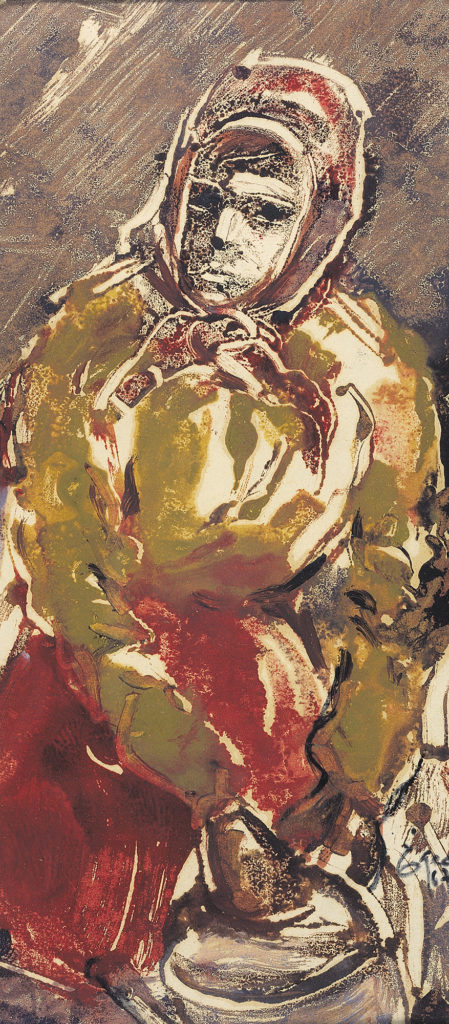Author’s Note: I thought a lot about which of the artists I knew and recognized I would prefer to see in my book Színes paletta. In each case, the painter Imre Égerházi came to mind. He was a nice man, and a good friend of mine. As a board member, I worked with him a lot at the Hortobágy Creative Camp. That is why I decided to post a snippet of one of our conversations. I do this to pay tribute to his memory in this way and to make this publication richer through his art.
A heartwarming statement from the outstanding Colombian painter Graciela Gomez, a member of the International Hortobágy Creative Camp, to art writer Lajos Arany during our conversation: “In 1992, when I first visited the Hortobágy Creative Camp, how strong the bond between Hungarians are… It is very touching and I can respect it very much. ” The painter was right. He also knew that an excellent organizer was needed to get together the artists. This organizer was the painter Imre Égerházi. With his help, the International Hortobágy Creative Camp became involved in the circulation of the international fine art scene through the artists attending there. In addition to its internationality, the artists’ colony was also notable for continuously following our national history from the very beginning, also as an artistic theme. The most special evidence of this is the panel exhibition in Hajdúhadház school and the Aranybika in Debrecen, a huge garland of works and a high-value fine art document.
Led by Imre Égerházi, there were artists who undertook noble tasks, who knew the uneasy history of the Hungarians, the past and the present, the relationship between man, nature and science. How important these are. After all, a nation that does not value its ancestors, its historical past, its culture, cannot draw from the past, cannot preserve its identity, cannot plan for its future.
Excerpt from my book “Szóla” Paraván, 1998
You mentioned several artists from whom you learned a lot. Who do you consider your master?
I really consider a man to be a master from whom I learned a lot, József Menyhárt. He was the one who picked me out of free school. What I know in art, I owe much of it to him.
How your art developed?
When I started, I really liked the paintings that resembled their model. Later, one develops and is supplemented. I removed the perspective on my paintings, painted in two planes. Stacking the sheets next to each other gave perspective. I completely left out the small details. I always went to the limit accepted by me internally. I also have a serious remark in this regard: the works carried the character of the era. They contained the human, social, emotional relations of the given era. I do not think this era we live in is an exception. Many painters do not care if what they depict happens in 2000, or even later. They do timeless painting. It’s annoying that I go to an exhibition hall and see almost only scribble painting. Or an ad hoc painting appears, even though this era we live in is like going on a wide, big country road where we see everything from the most accurate phenomena to the most abstract things. This should be reflected in the works.
Where do you get your topics from?
The deepest inspiration is Hajdúság, but I also love Transylvania. I brought a lot of pictures with me from there, where I painted a lot. My ancestors were Transylvanian and were very famous 400 years ago.
Since 1981 you have been the leader of the Hortobágy Creative Camp. How and for what purpose was the camp established?
László Végh asked me to start this colony in the Hortobágy inn. We started by calling Westerners. Other artists’ colonies were hardly had any Westerners at the time, and rather preferred ones from East. Being first in something, going through something that many don’t want: it’s always the hardest. Now it is the case at the moment that painters come from 18-20 countries all over the world every year.
Your creative house is in your hometown. Why are you so attached to Hajdúhadház when being a resident of Debrecen?
I was born there; I went to school there. For a long time, I cultivated the land instead of my father. My relationship with relatives did not end. I have a very nostalgic desire to take that poor and disadvantaged settlement a little further.
So far, you have organized and conducted two panneau exhibitions. One in Hajdúhadház, the other in the Aranybika.
National value was created in Hajdúhadház – we made 26 panneaus there – and in Aranybika, where 18 were made. András Gaál and I made a panneau for the military grammar school. If I add this up, for 20 years in Hungary not as much has been made as we did. Many do not even know how much cultural value has been created.
If you won 10 million forints, what would you do with it?
I would give half to my family and the other half to Hajdúhadház to make a nice big gallery for contemporary artists and help make the city a very nice sculpture park.
Színes paletta, 2004,
by János Komiszár


